Landscape photography is an art that combines technical skills and creative vision to capture the beauty of nature. By mastering techniques such as long exposure and high dynamic range imaging, photographers can elevate their images, while thoughtful composition and optimal lighting conditions further enhance the visual storytelling. Understanding these elements is essential for creating stunning landscape photographs that resonate with viewers.
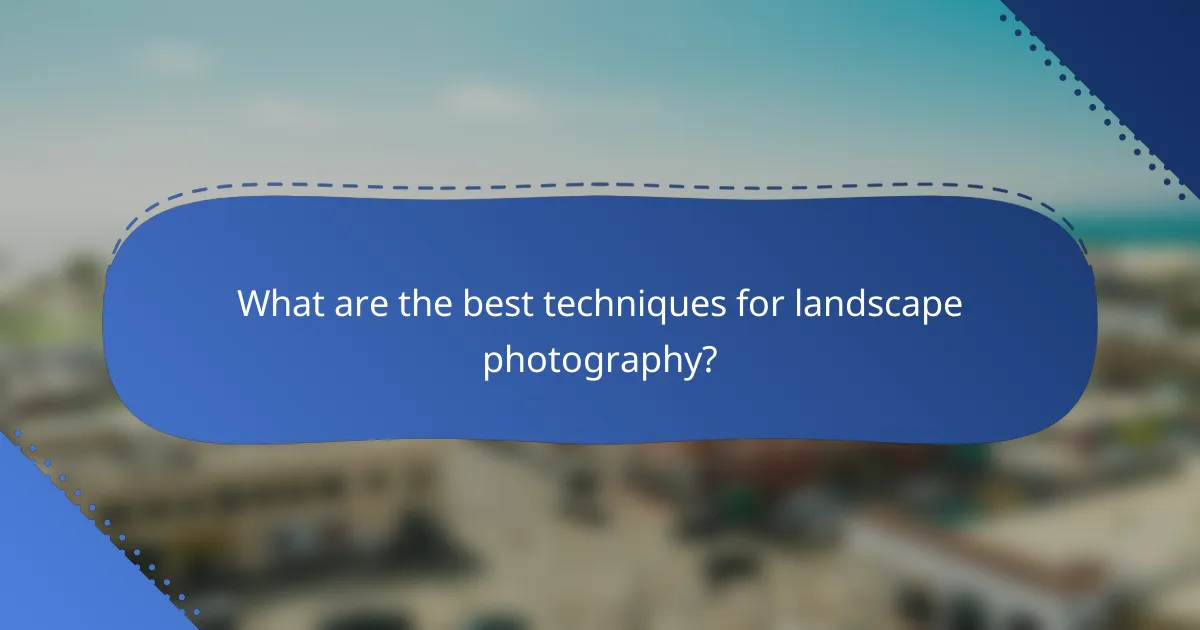
What are the best techniques for landscape photography?
The best techniques for landscape photography include long exposure, high dynamic range imaging, focus stacking, panorama stitching, and the use of filters. Each method enhances the quality and impact of landscape images by addressing specific challenges in capturing natural scenes.
Long exposure photography
Long exposure photography involves using a slow shutter speed to capture the movement of elements like water and clouds, creating a smooth, ethereal effect. This technique is particularly effective during dawn or dusk when light conditions are softer.
To achieve long exposures, use a tripod to stabilize your camera and consider using neutral density filters to reduce light entering the lens. Aim for exposure times ranging from a few seconds to several minutes, depending on the desired effect and lighting conditions.
High dynamic range imaging
High dynamic range (HDR) imaging captures a wider range of light and detail in both shadows and highlights by combining multiple exposures of the same scene. This technique is useful in high-contrast environments, such as sunrise or sunset landscapes.
To create an HDR image, take at least three photos at different exposures: one for the highlights, one for the mid-tones, and one for the shadows. Use software to merge these images, ensuring that details are preserved across the tonal range.
Focus stacking
Focus stacking is a technique that combines multiple images taken at different focus distances to achieve greater depth of field. This is especially beneficial in landscape photography where foreground and background details are important.
To implement focus stacking, take several images with varying focus points, from the foreground to the background. Use editing software to align and blend these images seamlessly, ensuring sharpness throughout the entire scene.
Panorama stitching
Panorama stitching allows photographers to capture wide landscapes by combining several images into a single, expansive photo. This technique is ideal for vast vistas that cannot be captured in one frame.
When creating a panorama, overlap each shot by about 30% to ensure smooth stitching. Use a tripod for stability and maintain consistent exposure settings across all images to avoid discrepancies in lighting.
Use of filters
Filters are essential tools in landscape photography that help control light and enhance colors. Common types include polarizing filters, which reduce glare and enhance saturation, and neutral density filters, which allow for longer exposures without overexposing the image.
When using filters, consider the time of day and weather conditions. A polarizing filter is most effective in bright sunlight, while neutral density filters can be used during any time to achieve desired exposure effects. Always check for vignetting, especially with wide-angle lenses.
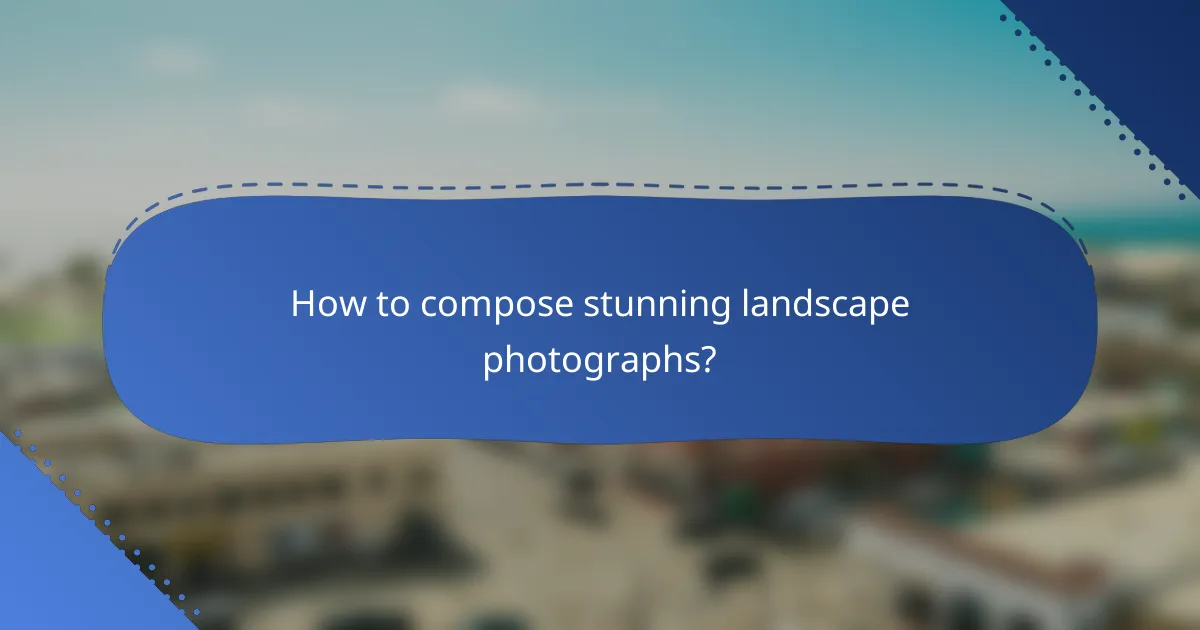
How to compose stunning landscape photographs?
To compose stunning landscape photographs, focus on the arrangement of elements within the frame to create balance and draw the viewer’s eye. Effective composition techniques enhance the visual impact and storytelling of your images.
Rule of thirds
The rule of thirds is a fundamental composition technique that divides the frame into a 3×3 grid. Placing key elements along these lines or at their intersections can create a more dynamic and engaging image. For example, positioning the horizon along the top or bottom third can emphasize either the sky or the foreground.
When applying this rule, consider the balance of elements in your scene. Avoid centering your subject; instead, experiment with different placements to see what feels most natural and visually appealing.
Leading lines
Leading lines are pathways or lines within the landscape that guide the viewer’s eye toward the main subject. These can be roads, rivers, or rows of trees that create a sense of depth and perspective. Utilizing leading lines effectively can enhance the three-dimensional feel of your photograph.
To maximize their impact, ensure that the lines lead directly to your focal point. This technique can help create a narrative within the image, inviting viewers to explore the scene further.
Framing techniques
Framing techniques involve using elements within the scene to create a “frame” around your subject, which can help isolate it and draw attention. Natural frames can include overhanging branches, archways, or rock formations. This method adds depth and context to your landscape photographs.
When using framing, be mindful of the balance between the frame and the subject. Ensure that the framing elements do not overpower the main focus of the image, but rather complement it.
Foreground interest
Incorporating foreground interest adds depth and context to landscape photographs, making them more engaging. This can be achieved by including elements like flowers, rocks, or water in the foreground, which can lead the viewer’s eye into the scene.
When selecting foreground elements, consider their size and placement. They should enhance the composition without distracting from the main subject. Experiment with different angles and perspectives to find the most compelling arrangement.
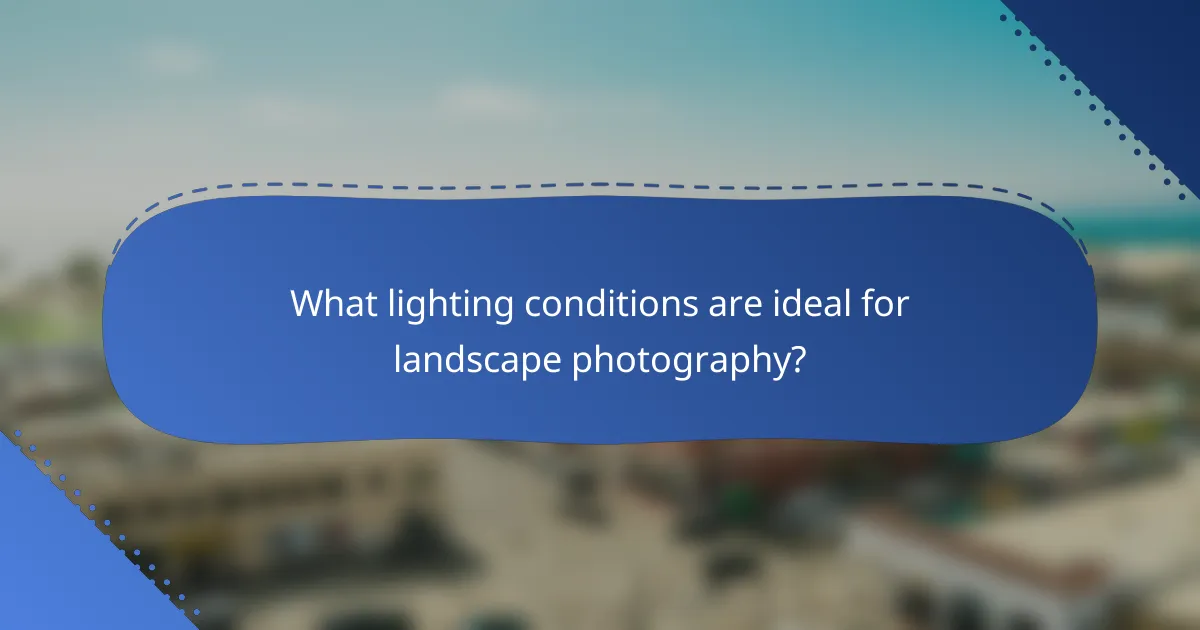
What lighting conditions are ideal for landscape photography?
Ideal lighting conditions for landscape photography include the golden hour, blue hour, and overcast skies. Each of these conditions offers unique qualities that can enhance the mood and detail of your images.
Golden hour lighting
Golden hour lighting occurs shortly after sunrise and before sunset, providing a warm, soft glow that enhances colors and textures. The angle of the sun during this time creates long shadows and adds depth to landscapes.
To make the most of golden hour, plan your shoots around these times. The light can change rapidly, so be prepared to adjust your settings quickly. Aim to arrive at your location early to scout compositions and set up your equipment.
Blue hour lighting
Blue hour lighting happens just before sunrise and after sunset, characterized by a cool, bluish hue. This period offers a unique atmosphere, ideal for capturing serene landscapes and cityscapes with a tranquil feel.
During blue hour, the sky can produce stunning gradients, making it a great time for long exposure shots. Use a tripod to stabilize your camera and experiment with longer shutter speeds to capture the soft light and movement in the scene.
Overcast conditions
Overcast conditions provide diffused light, reducing harsh shadows and creating a soft, even illumination across the landscape. This type of lighting is particularly effective for capturing details in foliage and textures in the environment.
When shooting in overcast weather, consider using a polarizing filter to enhance colors and reduce glare. This can help bring out the vibrancy of greens and blues, making your images more striking even in dull conditions.
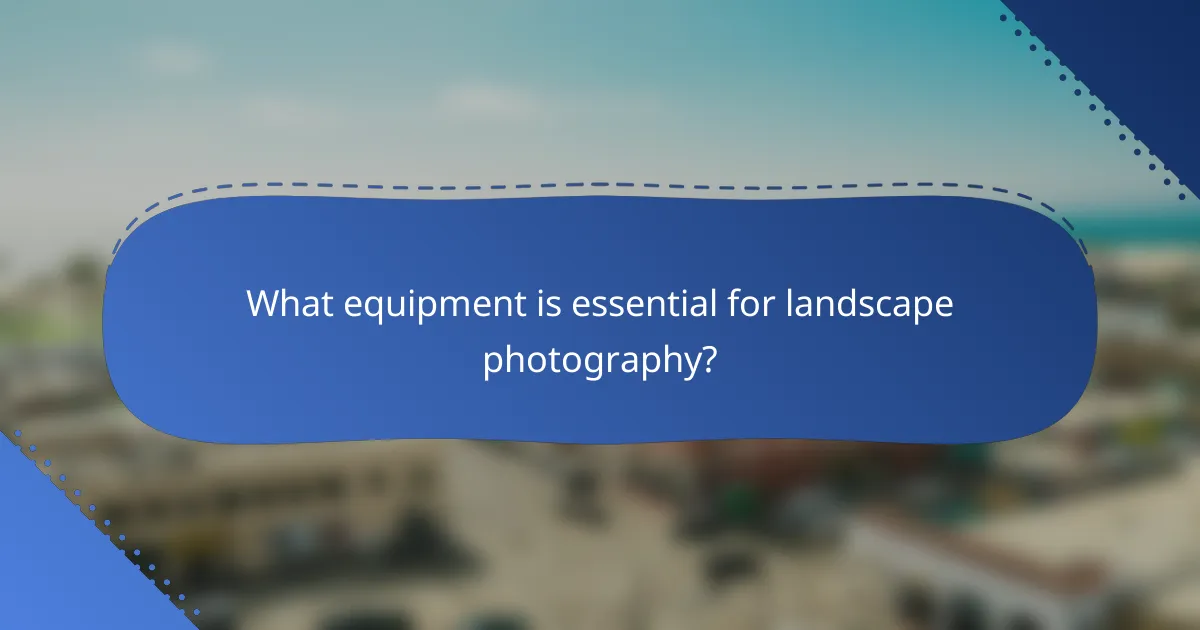
What equipment is essential for landscape photography?
Essential equipment for landscape photography includes a reliable camera, a wide-angle lens, a sturdy tripod, and neutral density filters. These tools help capture stunning images with clarity and depth, allowing photographers to effectively manage light and composition.
DSLR or mirrorless camera
A DSLR or mirrorless camera is crucial for landscape photography due to its ability to capture high-resolution images with excellent detail. These cameras offer manual controls, allowing photographers to adjust settings like aperture and shutter speed for optimal results.
When choosing between a DSLR and a mirrorless camera, consider factors such as weight, battery life, and lens availability. Mirrorless cameras tend to be lighter and more compact, while DSLRs often have longer battery life and a wider selection of lenses.
Wide-angle lens
A wide-angle lens is essential for landscape photography as it allows you to capture expansive scenes and dramatic perspectives. Typically, lenses with a focal length of 14mm to 24mm are ideal for this purpose.
Using a wide-angle lens can create a sense of depth and scale in your images. Be mindful of distortion, especially at the edges of the frame, and consider using post-processing software to correct any issues.
Tripod
A sturdy tripod is vital for landscape photography, especially in low-light conditions or when using slow shutter speeds. It stabilizes the camera, preventing blurriness and allowing for longer exposures without camera shake.
When selecting a tripod, look for one that is lightweight yet durable, with adjustable height and a quick-release plate for convenience. Avoid flimsy models that may not withstand windy conditions or uneven terrain.
Neutral density filters
Neutral density (ND) filters are useful for controlling exposure in landscape photography, particularly in bright conditions. They reduce the amount of light entering the lens, allowing for longer shutter speeds and wider apertures without overexposing the image.
Consider using ND filters when photographing waterfalls or seascapes to create a smooth, silky effect in the water. A range of ND filters (e.g., 3-stop, 6-stop, 10-stop) can provide flexibility for different lighting situations, so having a few on hand is beneficial.
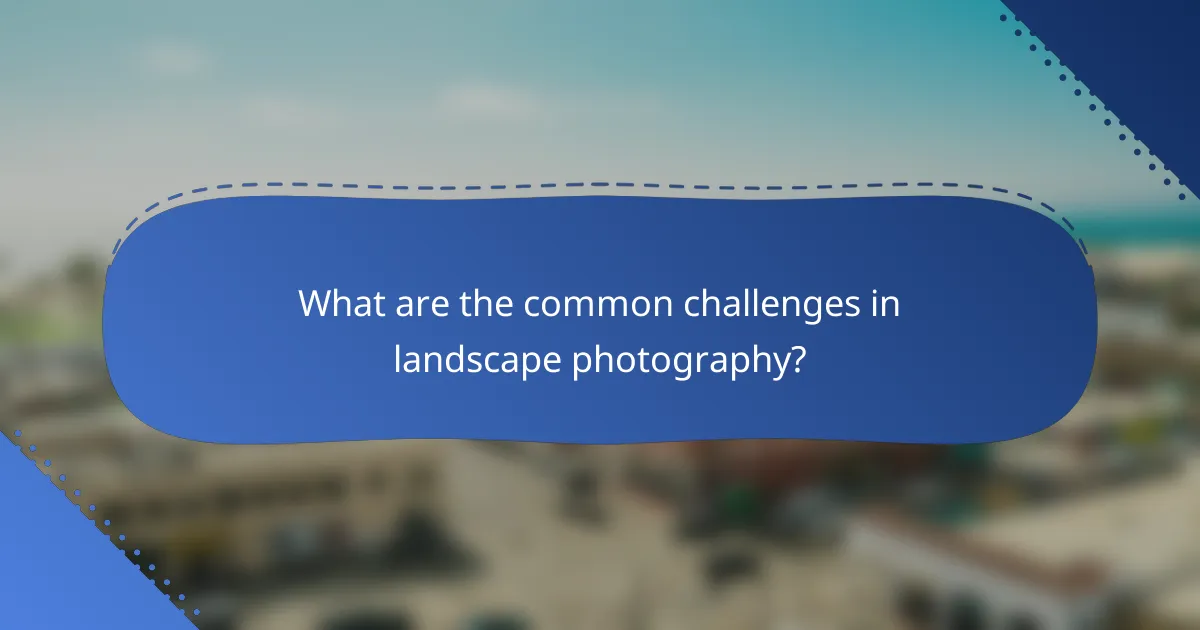
What are the common challenges in landscape photography?
Common challenges in landscape photography include dealing with changing weather conditions, managing light effectively, and composing scenes that capture the essence of the landscape. Photographers often face difficulties in achieving the right exposure and depth of field while also contending with unpredictable elements like wind and light shifts.
Weather Conditions
Weather can significantly impact landscape photography, affecting both visibility and lighting. Photographers should be prepared for sudden changes, such as rain or fog, which can either enhance or obstruct a scene. Utilizing weather apps can help anticipate conditions, allowing for better planning.
Lighting Challenges
Lighting is crucial in landscape photography, with the golden hours—shortly after sunrise and before sunset—providing the most flattering natural light. However, harsh midday sun can create unwanted shadows and highlights. Using filters, such as polarizers or ND filters, can help manage light and enhance colors.
Composition Issues
Effective composition is vital for creating compelling landscape images. Photographers should consider the rule of thirds, leading lines, and framing to guide the viewer’s eye through the image. It’s beneficial to experiment with different angles and perspectives to find the most striking composition.
Equipment Limitations
Equipment can also present challenges, particularly for those using entry-level cameras or lenses. Investing in a sturdy tripod can improve stability and allow for longer exposures, which is essential in low light conditions. Additionally, understanding the capabilities and limitations of your gear can help in making informed decisions during shoots.
